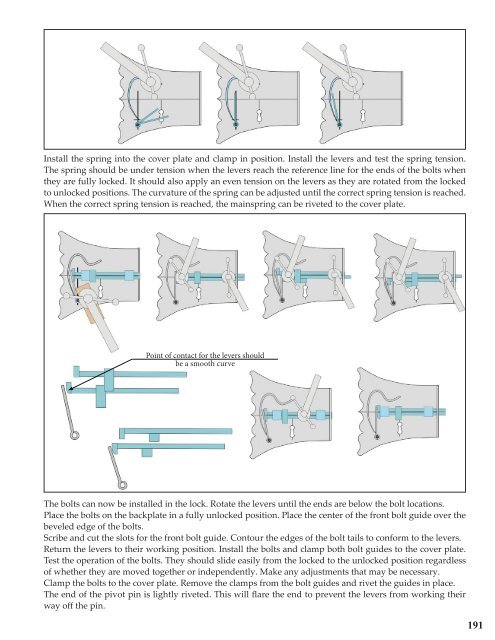The New Spruce Forge Manual of Locksmithing: A Blacksmith’s Guide to Simple Lock Mechanisms
The New Spruce Forge Manual of Locksmithing: a Blacksmith’s Guide to Simple Lock Mechanisms is a totally revised and expanded version of the original work from 1999. This new hardcover edition, at 304 pages and with more than 800 color photos and illustrations, is more than double the size of the original manual. It is divided into two distinct sections: Technical Information - This section is a reference manual in itself that covers the specific tools and techniques needed to build all the parts for each lock, as well as providing the information needed to understand the assembly instructions outlined in the second section. The Locks: Patterns & Instructions - This section provides the plans and detailed instructions for each of the 14 lock projects in this new edition. The clear assembly instructions describe when and how to use the technical information provided in section one. The authors have maintained their original trademark style that relies on well-illustrated step-by-step instructions that guide you through the whole lock-making process. They have also kept their low-tech approach that demonstrates how to go about creating good work using only a handful of simple tools. Making blacksmith locks is an age-old skill the authors of this manual are helping to preserve by passing on their knowledge to this book’s readers. The New Spruce Forge Manual of Locksmithing is also an excellent introduction to benchwork, which is a useful skill for any blacksmith to acquire. This manual will become a valuable, trusted and often referred to sourcebook in your blacksmithing library. Hardcover, 304 pages, more than 800 photos and illustrations.
The New Spruce Forge Manual of Locksmithing: a Blacksmith’s Guide to Simple Lock Mechanisms is a totally revised and expanded version of the original work from 1999. This new hardcover edition, at 304 pages and with more than 800 color photos and illustrations, is more than double the size of the original manual.
It is divided into two distinct sections:
Technical Information - This section is a reference manual in itself that covers the specific tools and techniques needed to build all the parts for each lock, as well as providing the information needed to understand the assembly instructions outlined in the second section.
The Locks: Patterns & Instructions - This section provides the plans and detailed instructions for each of the 14 lock projects in this new edition. The clear assembly instructions describe when and how to use the technical information provided in section one.
The authors have maintained their original trademark style that relies on well-illustrated step-by-step instructions that guide you through the whole lock-making process. They have also kept their low-tech approach that demonstrates how to go about creating good work using only a handful of simple tools.
Making blacksmith locks is an age-old skill the authors of this manual are helping to preserve by passing on their knowledge to this book’s readers. The New Spruce Forge Manual of Locksmithing is also an excellent introduction to benchwork, which is a useful skill for any blacksmith to acquire. This manual will become a valuable, trusted and often referred to sourcebook in your blacksmithing library.
Hardcover, 304 pages, more than 800 photos and illustrations.
Create successful ePaper yourself
Turn your PDF publications into a flip-book with our unique Google optimized e-Paper software.
Install the spring in<strong>to</strong> the cover plate and clamp in position. Install the levers and test the spring tension.<br />
<strong>The</strong> spring should be under tension when the levers reach the reference line for the ends <strong>of</strong> the bolts when<br />
they are fully locked. It should also apply an even tension on the levers as they are rotated from the locked<br />
<strong>to</strong> unlocked positions. <strong>The</strong> curvature <strong>of</strong> the spring can be adjusted until the correct spring tension is reached.<br />
When the correct spring tension is reached, the mainspring can be riveted <strong>to</strong> the cover plate.<br />
Point <strong>of</strong> contact for the levers should<br />
be a smooth curve<br />
<strong>The</strong> bolts can now be installed in the lock. Rotate the levers until the ends are below the bolt locations.<br />
Place the bolts on the backplate in a fully unlocked position. Place the center <strong>of</strong> the front bolt guide over the<br />
beveled edge <strong>of</strong> the bolts.<br />
Scribe and cut the slots for the front bolt guide. Con<strong>to</strong>ur the edges <strong>of</strong> the bolt tails <strong>to</strong> conform <strong>to</strong> the levers.<br />
Return the levers <strong>to</strong> their working position. Install the bolts and clamp both bolt guides <strong>to</strong> the cover plate.<br />
Test the operation <strong>of</strong> the bolts. <strong>The</strong>y should slide easily from the locked <strong>to</strong> the unlocked position regardless<br />
<strong>of</strong> whether they are moved <strong>to</strong>gether or independently. Make any adjustments that may be necessary.<br />
Clamp the bolts <strong>to</strong> the cover plate. Remove the clamps from the bolt guides and rivet the guides in place.<br />
<strong>The</strong> end <strong>of</strong> the pivot pin is lightly riveted. This will flare the end <strong>to</strong> prevent the levers from working their<br />
way <strong>of</strong>f the pin.<br />
191










